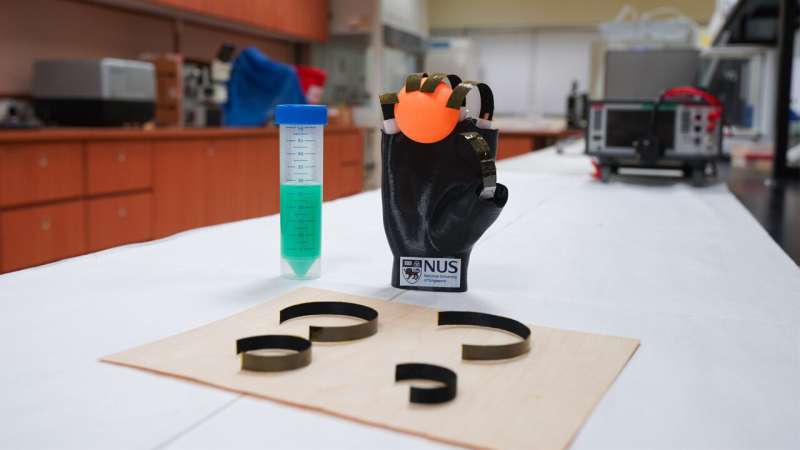This article has been reviewed according to Science X's editorial process and policies. Editors have highlighted the following attributes while ensuring the content's credibility:
fact-checked
peer-reviewed publication
trusted source
proofread
Researchers develop first-ever wooden robotic gripper that is driven by moisture, temperature and lighting

Most robotic grippers are made using either soft plastics—to pick up objects without damaging them—that melt at high temperatures, or metals which are stiff and costly. A team of researchers from the National University of Singapore (NUS), together with their collaborators from the Northeast Forest University, have created a wooden robotic gripper that could be used in a very hot environment and yet maintain a tender touch.
This innovative wooden robotic gripper also has another advantage—it is driven by changes in moisture, temperature and lighting in the environment, hence lowering energy consumption.
"Wood has excellent mechanical properties, natural deformation, available in large reserves, and is relatively cheap. In our latest work, we have shown that wood-based robotic grippers can overcome the limitations of traditional actuators and manipulators," explained Assistant Professor Tan Swee Ching, who leads a research team from the Department of Materials Science and Engineering under the NUS College of Design and Engineering.
He added, "Our wooden robotic gripper can spontaneously stretch and bend itself in response to moisture, thermal and light stimulation. It also has good mechanical properties, able to perform complex deformation, wide working temperature range, low manufacturing cost, and is biocompatible. These unique features set it apart from conventional alternatives."
The wooden gripper opens up when exposed to high humidity (above 95% RH), and closes tightly when the temperature of the surroundings increases beyond 70°C or when they are exposed to solar radiation.
The research team published their invention in the online version of scientific journal Advanced Materials on February 26, 2023.
A wooden gripper that is sensitive to moisture, thermal and light
The researchers created the wooden robotic gripper using pieces of Canadian maple wood that are 0.5 mm thin. The pieces of wood were first treated with sodium chloride to remove the lignin—a component found in the cell walls of plants. The large pores in the wood are filled with a polymer called polypyrrole to enable the material to absorb heat and light more easily.
The team also formulated a new nickel-based hygroscopic gel for moisture absorption. One side of the modified wood pieces was coated with the moisture-absorbing gel. A hydrophobic film was attached to the other side. This wet-dry difference allows the wood quickly absorb water vapors on one side, and this accelerates changes in the shape of the wooden gripper when exposed to high humidity.
The wood pieces were then shaped into a gripper at 70°C using special molds. When placed in an environment with 95% RH (i.e. moisture stimulation), the hygroscopic gel took in moisture and the wooden gripper stretched and gradually opened outwards.
"When exposed to high ambient temperature of beyond 70°C (heat stimulation), the wooden gripper started to bend inwards and achieved maximum bending at 200°C," explained Ms. Bai Lulu, doctoral student at the NUS Department of Materials Science and Engineering and first author of the paper.
The team also tested the wooden gripper under different light intensities, with the hydrophobic film layer facing the light source. When the light illumination increased the gripper's surface temperature to about 42°C, the moisture-absorbing gel started to lose water and the gripper began to bend inwards before achieving significant bending at about 57°C.
The wooden gripper remained intact after 100 actuating cycles, demonstrating its stability and robustness for long-term use.
Lifting objects at high temperatures
"We also verified the performance of the wooden gripper by pick up objects at high temperatures. In our experiments, the wooden gripper successfully lifted a weight of 200 grams (equivalent to a can of soda) at around 170°C. This is impossible for most actuators made using soft polymer. Depending on the design, the wooden gripper could carry loads as high as 10,000 times the weight of the gripper," explained Professor Chen Wenshuai from Northeast Forest University and the co-corresponding author of the research paper.
Asst Prof Tan and his team are now looking at improving the performance of the wooden gripper, such as shortening the bending time from about two minutes currently, increasing the weight load it can carry, as well as gripping objects with different shapes and sizes. They are also finding ways to reduce cost and to scale up the fabrication of the wooden gripper.
With further structural design and performance improvement, the team hopes to develop improved version of the wooden gripper to help fire fighters carry out rescue operations.
More information: Lulu Bai et al, Hygrothermic Wood Actuated Robotic Hand, Advanced Materials (2023). DOI: 10.1002/adma.202211437



















